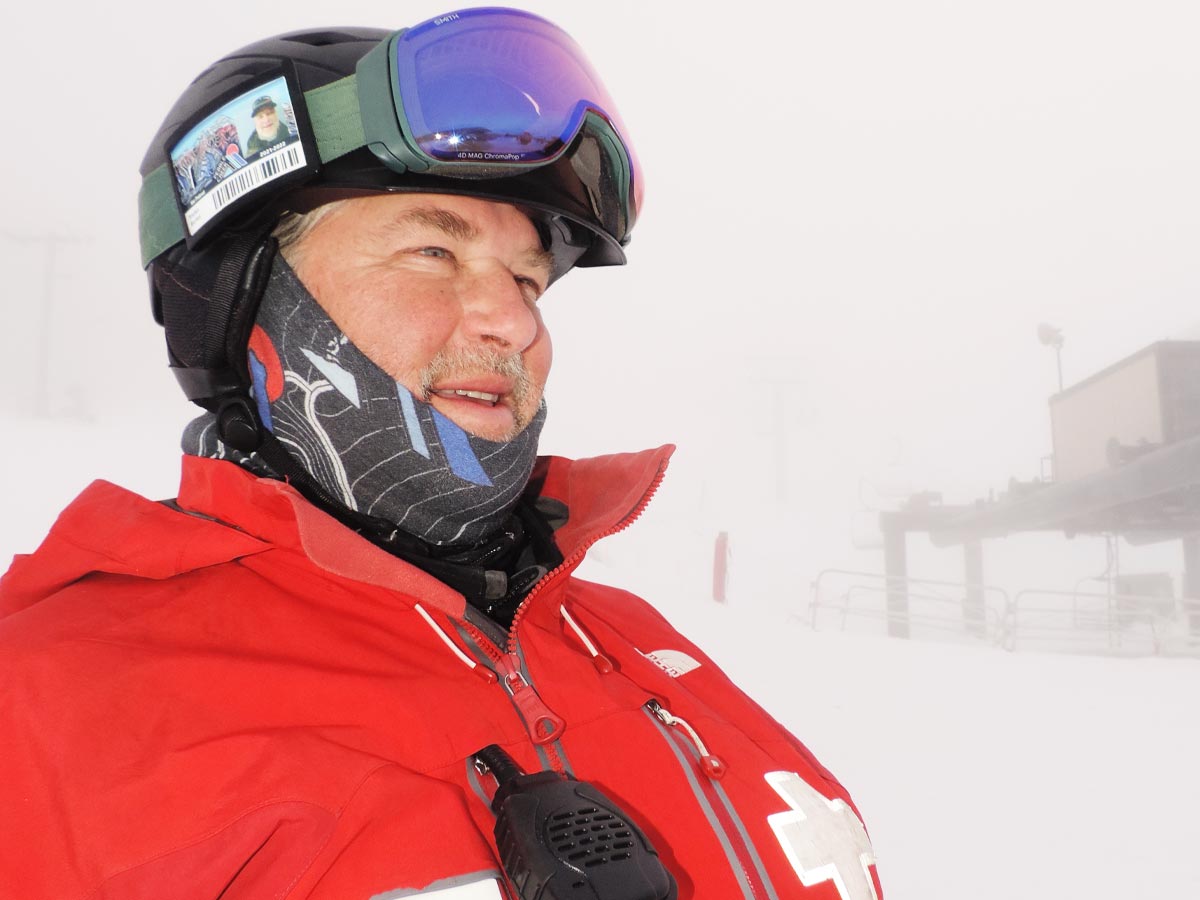Hollywood scriptwriters cannot imagine the heroic deeds of longtime ski patrollers who have each devoted five decades of their lives to keep the slopes safe at Pebble Creek Ski Area in southeastern Idaho near Pocatello.
“We’re not heroes, we’re just doing what we love,” said Mike Kirkland, 68, who became a ski patroller as soon as he was old enough at age 16. “You never know what’s going to happen here.”
Kirkland grew up skiing at Pebble and followed in the tracks of his father, Max, who was a patroller.
“He died of a heart attack the day after saving some kids in an avalanche, so we named a run, Max Out, in his honor,” Kirkland said. “Every time I come up, the first run I make is for him. I tell him, ‘This one’s for you, Dad.’”
At the ski patrol building during a break, Kirkland and other longtime patrollers reminisce about their half-century of service. Kirkland laughs with Joe Lehman, 76, a patroller since 1974, and Jerry Waters, 71, in his 52nd season on the patrol.
Working as behind-the-scenes guardians, Kirkland, Lehman, and Waters, along with others, have no intention of retiring from the patrol. They’ve rescued countless injured skiers, knowing the triumph of saving avalanche victims and the tragedy of recovering fatalities.
They are among 85 volunteer patrollers at Pebble Creek, who intentionally put themselves at risk to keep people safe. It’s a job they said they gladly do without pay because they treasure the rewards money cannot buy—providing first aid to skiers and cutting first tracks in fresh powder.
Instead of being paid, they pay yearly dues to National Ski Patrol, a nonprofit dedicated to service, safety, and education. They are among NSP’s 30,000 members at more than 600 patrols nationwide. Before lifts open, patrollers set explosives to dislodge potential avalanches, mark obstacles, and rope off areas that lack snow coverage. To keep their skills honed, they take annual refresher courses in first aid, avalanche prevention, and lift evacuation.
“I’m sincerely blessed to lead this patrol and to ski here,” said Stefan Berkel, 52, ski patrol director since 2006 and a ski patroller since he was 20. Before working at Pebble, he was ski patrol director at Utah Olympic Park, a winter sports park built near Park City for the 2002 Winter Olympics. He had also previously worked at Park City Mountain and Silverton Mountain in Colorado.
“When I heard about this job at a summer instructor training, I jumped,” Berkel said. “The ski area is a gem with the terrain, and I wanted to be able to use my avalanche dog. Plus, the patrol here is like family, unlike corporate ski areas where employees tend to be a number. We all have really different personalities, but we’re here for each other.”
Patrollers organize fundraisers for members.
“A patroller’s daughter was in a car wreck driving home after skiing and was in a coma for about six weeks,” Kirkland said. “We raised money to help pay for her medical bills. She recovered, then donated money back to the patrol.”
Generally Berkel schedules six patrollers during a weekday and 12 on weekends.
“I never have trouble staffing the shifts because patrollers are dependable and love their jobs,” he said.
When Berkel was hired, Kirkland, Lehman, Waters, and others shared their insights about the ski area with him. Renowned for its steep and challenging terrain, 43 percent of the runs are rated advanced or black diamond, while 10 percent are expert or rated double black diamond.
The saying is that if you can ski Pebble, you can ski anywhere. Nationally competitive skiers and snow boarders have trained there.
With the steep terrain, avalanche prevention is crucial.
“We do our best to educate our guests about avalanche dangers,” Berkel said. “We do routine avalanche control inside our boundaries but aren’t responsible for doing it out-of-bounds. Still, if someone has an accident out-of-bounds, we have a memorandum of understanding with law enforcement to respond.”
Poignant Memories
Avalanches are particularly poignant for Kirkland. Riding up the lift on January 7, 1995, with their shift nearly done, he and his father were dispatched to recover four teens who had hiked above the lift to find fresh powder and had triggered an avalanche. One went for help, while two were partially buried, and one had vanished.
“All 12 of us made a line, elbow to elbow, and started pushing our avalanche probes 6 feet down—then we moved one foot forward and did it again,” Kirkland said. “I hit the buried skier on his head and could hear him gasping for air beneath the snow. We dug him out in time. He was lucky to have survived.”
Meanwhile, Max and others dug out two teens who were buried to their waists.
“Dad rode down the lift with them to reassure and calm them,” Mike said. “He died of a heart attack the next day. He was only 64. I think the exertion of responding to the accident impacted his heart. The kids came to his funeral.”
Not all avalanche rescues are triumphant. Three fatalities occurred, the most recent in 2020 near the end of the season in an out-of-bounds area. A seasoned backcountry skier, Phil Bregitzer, 60, perished in an avalanche while skiing with friends. Patrollers recovered his body.
In 1963, an avalanche class instructor and his wife perished.
“They were probing snow and triggered an avalanche,” Waters said. “My brother was in the class with them. When they were found, they were upside down and vertical.”
Although serious about avalanche control, patrollers laugh about how avalanche mitigation has evolved and become safer. In the 1970s, they trained with the prototype of a device called an Avalauncher. Lehman explained it basically used compressed air to launch a charge through a plastic pipe. A fickle device, they had a learning curve to aim and calibrate the amount of pressure needed to hit targets.
“Sometimes we overshot,” Lehman said. “Other times, a charge wouldn’t detonate, so I’d get voted to be the one to deal with it. You’d tape a new cap and fuse to it, then light it and run. Other times, I was the one lowered by a rope to put a charge at a certain place. Why was it always me for those jobs?”
They all laughed.
“Our charges and detonation methods are safe and stable today,” Berkel said.
Astounding Injuries
Some accidents are unforgettable. Injured skiers survived what could have been fatal injuries if patrollers had not intervened.
One skier jumped off a cat track and got his ski pole stuck into his femoral artery when he landed.
“By the time we got there, he’d pulled it out. Blood was spurting everywhere,” said Kirkland. “A patroller had to ride the toboggan down with him and apply direct pressure to the artery, so he wouldn’t bleed out.”
The victim lived to ski again.
Then there was a speeding skier who overshot a cat track, landed on rocks, and ruptured his spleen.
“We had to move fast on that one to get him to the ambulance,” Lehman said. “He lived.”
A gratifying rescue for patroller Pat Parker happened out of bounds a few years ago.
“Some kids in Canal Street were jumping off cornices,” said Parker, 66, a patroller at Pebble Creek since 2003. “One landed on hard snow and broke his back. Six of us went in and brought him down on a toboggan. It was tough with a crust of snow we kept breaking through. I couldn’t believe it—he had surgery and was able to walk again.”
Parker said volunteering on ski patrol is an honor. “Some people donate blood to serve their community. Patrolling is a fun way for me to provide a service.”
He specializes in teaching new patrollers and refreshing seasoned patrollers in using a toboggan to retrieve injured skiers.
A lifelong skier, Kirkland joked he has been free of injuries in spite of himself.
“On my days off from the patrol when I was young, I lost track of the number of times I was thrown out for the day—for skiing out of bounds or doing a jump that was too high or long,” Kirkland said, laughing. “Somehow I survived.”
As if on cue, to fulfill Kirkland’s comment about unpredictable days at Pebble Creek, an inexplicable power outage occurred, interrupting their reminiscing.
“We’ll get an auxiliary engine going to power the lift and ride up behind the public,” Waters explained. “Then we’ll do our normal sweep procedures to be sure no one is still on the hill.”
Fog enshrouded the mountain, and the patrollers disappeared into the mist.
“You wait,” Kirkland said, smiling. “It’s always golden here by the end of the day.”
He was right. In about 90 minutes, power was restored, sunshine broke through, and he was able to squeeze in a few extra runs —“definitely for Dad.” ISI










